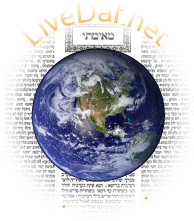According to the opinion that a Lechi functions based on the principle of mechitza, how can a Lechi be less than three tefachim which is generally considered Lavud?
Tag Archives: caravan
Eruvin 14 – עירובין יד
Click here to view text of Daf (can be minimized alongside player)
Play Audio Only Download Audio Download Video Diagram 1 Diagram 2 Diagram 3
Today’s Daf Yomi Question:
According to the opinion that a Lechi functions based on the principle of mechitza, how can a Lechi be less than three tefachim which is generally considered Lavud?
Eruvin 15 – עירובין טו
The Mishna says a Pirtza greater than ten nullifies the Mechitza. Perhaps this only applies to this type of vertical-only Mechitza described here; how do we know this applies also to a properly constructed Mechitza?
Eruvin 15 – עירובין טו
Click here to view text of Daf (can be minimized alongside player)
Play Audio Only Download Audio Download Video Diagram 1 Diagram 2 Diagram 3
Today’s Daf Yomi Question:
The Mishna says a Pirtza greater than ten nullifies the Mechitza. Perhaps this only applies to this type of vertical-only Mechitza described here; how do we know that this will also apply to a properly constructed Mechitza?
Eruvin 16 – עירובין טז
Click here to view text of Daf (can be minimized alongside player)
Play Audio Only Download Audio Download Video Diagram 1 Diagram 2 Diagram 3 Diagram 4 Diagram 5 Diagram 6
Today’s Daf Yomi Question:
Abaye explains that the Rabanan agree that a ‘Makom Chashuv’ is only achieved with four tefachim; if so how can we explain that Lavud is set at three?
Tosfos writes, that although we conclude in the Gemara that half Omed half Parutz is fine, that won’t necessarily apply to other area such as issur or tuma, where half and half may not be sufficient – how can we explain this difference?
Eruvin 16 – עירובין טז
Abaye explains that the Rabanan agree that a ‘Makom Chashuv’ is only achieved with four tefachim; if so how can we explain that Lavud is set at three?
Tosfos writes, that although we conclude in the Gemara that half Omed half Parutz is fine, that won’t necessarily apply to other area such as issur or tuma, where half and half may not be sufficient – how can we explain this difference?
Eruvin 93 – עירובין צג
Rashi explains that one needs to be able to see the Mechitza of ten tefachim (according to Rav Chisda). If so, even when the ground is elevated a full ten tefachim but there is a shallow Mechitza at the edge (blocking view of the ten tefach elevation) how can it be considered a Mechitza?
